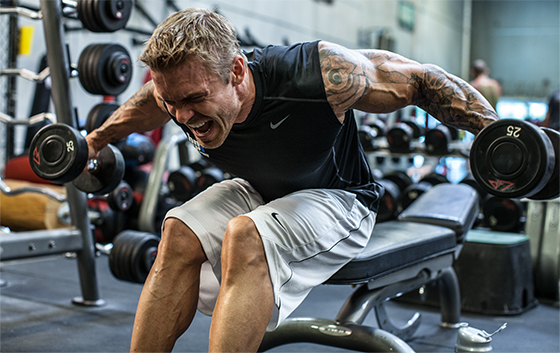
In my version of Doggkrapp’s training, I focus on what I like and benefit from it. This program is not radical, but it can be very effective. Try it yourself!
By Mark Subsinski
While surfing the internet, I came across numerous discussions of the Doggcrapp workout program. I was immediately interested and decided to learn more about the philosophy and style of the program. Then I thought about the training style and decided to incorporate most of this theory into my standard training by starting a new training cycle.
To understand the standard program mode, I have read many different materials on Doggkrapp. I first tried standard workouts based on the principles outlined in the classic Cycles for Pennies article. In addition, I made some changes to the program and adapted it to my needs and preferences.
My approach is to focus on and benefit from the things that I love. I’ll make a reservation right away that this approach describes my personal experience and differs from what could be considered “pure” Doggkrapp.
The basics
I don’t know exactly how this technique got its name, but the program has gained many supporters. It was developed by Dante Bautista, and among bodybuilders there is an ambiguous attitude towards her – she is either loved or hated, there is no middle ground. I’m not entirely sure why this is because the training style is not that radical.
As I mentioned earlier, Cycles for Pennies explores the principles of a workout program. You can also find the training diaries of those practicing with Doggkrapp. I have carefully studied some of them, which I advise you to do. However, it is worth noting that most training diaries cover only a short period of time and provide limited explanation and value.
Essence of Doggkrapp
So, what is the program, what is its essence, and what is my opinion about it? I will cover these questions in the course of my story. As for the main questions:
Is Doggkrapp’s training effective?
Yes. I can see a significant increase in strength, mass and weight.
Is it hard to follow the training regimen?
It’s not the same for everybody. The program will seem daunting to those who have not trained with such intensity before. Also, I would not recommend this method to beginners. This system is well suited for those who have more than a couple of years of training behind their backs.
Is Doggkrapp’s training the best workout program?
We will talk about this at the very end.
Program
Although I am not an author or much of Doggkrapp, I have enough experience to create my own interpretation and adaptation of the program. If you are looking for a classic training and appropriate dietary program, it is best to contact the author directly or one of his personally trained trainers.
One of the foundations of Doggkrappa is the loose application of the rarely used principle of overload, the rest-pause training . Rest-pause training is very intense and stimulates muscle growth. In addition, it allows you to use as many muscle fibers as possible for your workout.
Start with a set to failure. Then return the weight to its place and pause for 20-30 seconds. You can count either the time (20-30 seconds) or the number of breaths between sets.
I usually take 12-15 deep breaths between sets. After resting, do the second set with the same weight to failure. Pause and do the third and final set.
For the entire set, you should do about 10-25 reps in total. A set breakdown might look like this: 9 reps, then 4 reps, then 2 reps. For most of the exercises, I preferred to do more reps, about 13-18.
This system also has another advantage – the use of sets with high and low reps. The combination of both stimulates both muscle growth and strength development. Doggkrappa training also limits the number of sets to a specific muscle group. Often this is one or two sets (most rest-pause exercises are used when they can be done safely) and long stretches. The “explosive” positive and controlled negative phases set the speed of the set. Also, in more advanced stages, a static grip is considered – I use it very sparingly.
A smaller workout volume allows for faster recovery and shorter workout breaks. In two workouts, the whole body is worked out. The system usually provides training sessions on Monday, Wednesday and Friday. This split ensures that each body part is worked twice over an 8-day period.
The intensity level is quite high. The Dogcrappa program is a bit like Mentzer or Yats-style high-intensity training in that it focuses on doing a limited number of sets at maximum intensity. And, as with other high-intensity programs, the result is well-developed musculature.
Important aspects
Three other important aspects of the program are exercise rotation, training diary, and training breaks.
None of these principles are particularly radical. Most training programs include some of these elements. Doggkrappa training brings them together and sticks to them.
Alternating exercise
The program includes an alternation of 3 workouts, each of which includes specific exercises. The alternation is something like this – A1, B1, A2, B2, A3, B3, A1, B1, etc., where A stands for the upper body and B for the lower.
Training diary
The second important aspect of the program is keeping a training diary, which records the exercises, the weight of the weights and the number of repetitions. The idea of the diary is that each subsequent workout should be more intense.
For example, if you did 12 reps of the 120kg bench press in your first workout, then on your next A1 workout you should either increase the weight or do more reps with the same weight.
This way you progress with each subsequent workout. Due to the alternation of exercises, you have a break of 12 days between workouts of the same type. This should be enough time for recovery and growth, allowing you to do more reps or increase weights.
Breaks
The final important aspect of the program is a workout break to allow joints, tendons and the central nervous system to recover. I took a week break every 10 weeks of training.
Program adaptation
As I mentioned earlier, I have deviated slightly from the original program. Firstly, given the lack of time and the regenerative capacity of my body, I chose the three-day split. My out-of-the-gym activities often take precedence over my workouts. I have come to the conclusion that a two-day split is taking too long. In general, my three days of training were not consistent and varied from week to week depending on the work schedule.
Although I did a limited number of sets, I still needed good warm-up sets. Taking into account the hitch and rest between sets, the two-day split took about 90 minutes – a bit longer than I had time to do.
When I switched to a three-day split, one hour was enough for me. To adapt the training to


